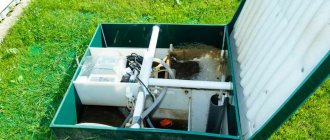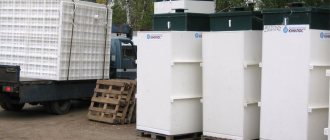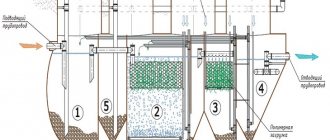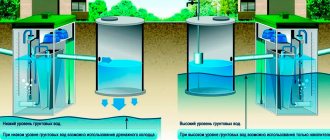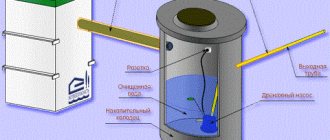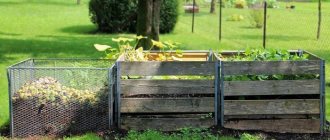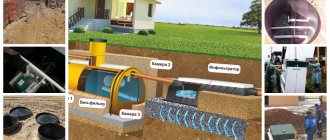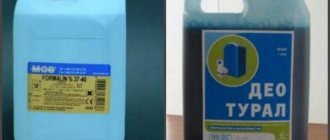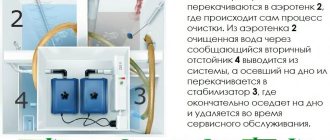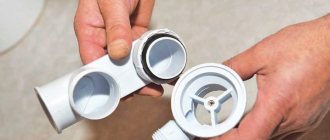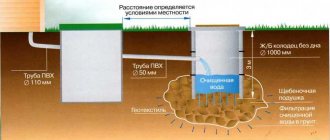Many summer cottages and country houses do not have the ability to connect to a central sewer system. Those who are tired of “running into the yard” in the rain and slush, sooner or later think about alternative solutions in terms of sewerage arrangement.
We will talk about how to choose an autonomous sewer system, and how the main market leaders differ from each other. If you are tired of biased ratings and reviews, when companies try to pass off what they sell as the best coin, then read the article comparing Unilos Astra, Topas, Eurobion, Biodeka and other biological treatment stations from our experts. We install all the most common types of sewer systems, which means we don’t try to sell just one thing.
Let's define the concepts
In this article we will talk specifically about autonomous sewerage - an energy-dependent installation that purifies wastewater over 98% and processes human waste products with the help of aerobic bacteria that are formed in the station as a result of a constant supply of oxygen.
Such sewers are also called biological treatment ; they are environmentally friendly for humans and the environment. The water from the treatment station comes out clear and odorless - it can be used for washing cars, paths, verandas, watering non-fruit trees and lawns. Such stations are also popularly called septic tanks, although this is not correct, but has firmly taken root in everyday life.
Autonomous sewerage purifies wastewater over 98% and operates for about 50 years.
Many people see an alternative to this sewage system in installing a conventional plastic septic tank, that is, a container with one or several compartments through which wastewater passes, gradually being purified. In fact, there is no alternative here - the wastewater coming out of such a septic tank is purified only up to 40%, has a cloudy color and a putrid odor, since the purification process occurs with the help of anaerobic bacteria.
Such a septic tank implies only partial settling of organic waste at the bottom of each compartment and requires regular pumping with a sewer truck when there is sufficient accumulation of organic waste at the bottom of the compartments. In fact, it is a slightly more advanced analogue of the cesspool, invented at the beginning of the century. With an almost identical cost to an autonomous sewer system due to expensive installation (to prevent the soil from being crushed by a plastic septic tank, concrete is poured, etc.), its disadvantages in the smell like a wooden toilet and the constant damage to flower beds by the wheels of a sewer truck are too obvious.
We think the disadvantages of a cesspool, well, etc. are not worth explaining. A huge pit or well with a lid (or without), which not only emits an odor, but is also extremely unsafe for children. Look how much news there is in Yandex searches about a child drowning in a cesspool.
It remains to be seen how such structures are still allowed to be built. Our company has never installed and does not install equipment that does not comply with GOSTs and safety standards. That is why we are in favor of autonomous sewerage.
Thus, we will immediately discard the septic tank as an option for arranging a sewer system. Next we will talk about the autonomous sewer system of a private house, which will serve you for over 50 years with proper care.
General information about autonomous sewerage in a private house ↑
The sewer system of the cottage consists of an internal and external part. The first collects wastewater from plumbing fixtures, and the second receives it and processes it or accumulates it for pumping.
Classic autonomous sewage system for a country house - septic tank and infiltrator (drainage)
The option with a storage tank can be immediately discarded, since with a large volume of sewage from a private house, it quickly overflows. And the constant call for sanitation workers will make a hole in the budget of any family. Wastewater from sewers must be treated on site and then drained into the soil.
You can organize wastewater treatment in a country house using:
- cesspool;
- anaerobic septic tank with several chambers;
- aerobic wastewater treatment plant.
The cesspool is simple and cheap to manufacture, but without problems it can only cope with a small volume of wastewater. Structurally, this is a container with drainage made of gravel and sand instead of a bottom. When entering the cesspool, organic matter from the wastewater is processed by anaerobic bacteria living in the ground, and the clarified water is drained into the ground.
You can make a cesspool from a variety of building materials. The undisputed leader in the cheapest rating is factory-made reinforced concrete rings. They just need to be brought to the site and folded into a single well structure.
It is even easier to install a plastic or fiberglass cesspool. This is a ready-made installation that just needs to be lowered to the bottom of a dug pit and covered with soil.
Advice! It is recommended to install a cesspool only in dachas where there is little drainage. For a private home, it is better to choose a full-fledged septic tank with greater power and a deeper degree of cleaning.
In addition to low power, sewer odors and non-compliance with sanitary requirements for private homes can also be added to the list of arguments against cesspooling. It is almost impossible to completely get rid of amber in the case of a cesspool. And when it overflows, all the untreated wastewater from it immediately ends up on the ground, polluting the ground and water sources around it.
Criteria for selecting treatment plants ↑
When choosing an autonomous sewer system for a country house, you first need to decide on the material for its manufacture. The most practical and popular are plastic, concrete and fiberglass. The last option is the most durable, but it is also more expensive than all the others.
A concrete structure will cost the least. However, almost all ratings are topped by plastic septic tanks. They are the undisputed leaders in terms of a combination of indicators and price/quality criteria.
A septic tank made of concrete rings is cheap, but is installed using special equipment
All septic tank models are divided into two categories:
- Anaerobic.
- Aerobic.
It is simply incorrect to compare them with each other in any single rating of autonomous sewers for a home. These types of septic tanks differ greatly in how they operate. Aerobes need constant supply of oxygen, but anaerobes do not.
Aerobic plants refer to local treatment facilities with bioremediation, which allows water after processing to be reused for irrigation or technical needs. And after anaerobic treatment, they can only be sent to a wine filter or drainage for final purification.
Reference! Stations with anaerobes are non-volatile installations, the operation of which does not require a connection to the electrical network. But aerobes need a constant supply of oxygen to live, which is supplied using an aerator and compressor.
The choice of septic tank model depends on:
- the number of people living in the house;
- regularity of sewerage use;
- terrain;
- soil characteristics and groundwater levels.
Also, when compiling ratings of autonomous sewers, the cost of the system and the need for its maintenance are taken into account. It’s one thing to install a septic tank and forget about it for a year. In the spring I cleaned it, preparing it for the new season, and no more worries. It’s a completely different matter if you have to constantly monitor the operation of the treatment plant.
Autonomous sewerage market overview
Today, there are many types of local sewerage from various manufacturers: Topas from Topol - Eco, Unilos Astra, Eurobion, Biodeka, Alta Bio, Topol from Eco - Grand, Vortex and others.
To understand which of them are the best autonomous sewage systems, let us turn to the history of the emergence of biological treatment stations .
The cleaning method itself using aerobic bacteria, which is now used in all autonomous sewers, was invented and patented by Czech engineer Jan Topol in 1994. In 1995, the patent was issued to other countries, including the Russian Federation.
It was this year that the first Czech Topas , which is the progenitor of the Topas septic tank, which we now see on the windows of engineering companies. That is, Topas is the original autonomous sewer system; other manufacturers only slightly modified the invention and introduced worthy competitors among cleaning equipment to the market.
The next manufacturer to begin producing biological treatment stations was Unilos Astra , which launched the production of sewage in 2001. The main and, in fact, the only significant difference between Astra and Topas is the presence of not two, but one compressor, which pumps water from one receiving chamber to another. This is neither a plus nor a minus, since two Topas compressors are NOT INTERCHANGEABLE, and if at least one breaks, it will need to be replaced.
Then other manufacturers began to catch up: Yubas, Deka, Eurobion in 2008, Biodeka in 2014, etc. Many of them are still regularly subject to various modifications.
This information does not indicate which autonomous sewage system is better, however, it shows where it all began and where to look for the progenitor.
Cost of septic tank Astra and BioDeka
The Astra septic tank (80,000 rubles) costs less than the BioDeka septic tank (83,600 rubles). In a model designed for 5 people, the price difference is 3,000 rubles. For such station costs, the difference is insignificant. In the model for 3 people (Astra 3 and BioDeca 3) the difference is more than 10,000 rubles.
Septic tank compressor Astra and BioDeka
The compressor is the heart of the septic tank. Without a compressor the station will not work. The compressor may fail, and replacing it will cost a lot of money, so you should be careful when choosing a compressor. SECOH (Japan) and THOMAS (Germany) compressors are installed in the UNILOS Astra septic tank; the country of origin of these compressors speaks for itself about the reliability of our products (this is confirmed in practice). It is difficult to say which one will be in your station, it all depends on the supply of septic tanks from Moscow, but sometimes you can choose a compressor. The BioDeka septic tank has a HAILEA compressor (China). The HAILEA compressor was designed specifically for our Russian conditions, so it does its job perfectly.
Solenoid valve, pros and cons
The main stumbling block for the UNILOS Astra septic tank is the solenoid valve. On the one hand this is an advantage, on the other hand it is a disadvantage. The advantage is that, thanks to the solenoid valve, the Astra septic tank can operate in two modes, thereby completing a full sewage treatment cycle. The disadvantage is that, like any other electrical part of the station, it can fail. Especially often, solenoid valves fail where there are power surges. In such places it is necessary to install a voltage stabilizer. BioDeka simply does not have an electromagnetic valve, since the station implements a different operating principle.
Grousers - necessary or not?
The BioDeka septic tank has lugs that allow the body to cling to the ground and not float up. Astra doesn't have them, but it does have more weight, which also allows the station to remain in the ground. Firstly, lugs are only needed where there are quicksands. If the quicksand is standard (not strong), then if the septic tank is installed correctly, with or without lugs, it will not float up. This means that lugs are not needed. If the quicksand is very strong, which happens only in 0.5% of cases, lugs and more weight will no longer help, and the station will have to be anchored. In the general sense, lugs are not particularly needed, but they certainly won’t be superfluous.
Results, which septic tank to choose Astra or BioDeka?
We looked at the main differences between UNILOS Astra septic tanks and BioDeka. As a result, we get that Astra and BioDeca have their own strengths and weaknesses, which make these septic tanks unique and different, so the choice of septic tank is yours. Some will be put off by the slightly higher price and components of the BioDeka septic tank, while others will be put off by the solenoid valve and heavy weight of the UNILOS Astra.
For all questions regarding BioDeka and Astra septic tanks, you can consult with RosSeptic specialists. You can find all prices for Astra and BioDeca on the Prices page. This article is constantly changing and being added, we monitor the latest changes and innovations in both Astra septic tanks and BioDeka septic tanks!
Autonomous sewerage rating
Our company has been on the market for 11 years and during this time has installed more than 8,300 objects. Based on sales data for 2005-2016. statistical data on the popularity of one or another type of treatment plant was obtained. The data is presented in a chart.
The diagram shows that the Unilos Astra models are the most popular, since they are the most acceptable in terms of price-quality parameters. Topas takes a confident second place, since after the manufacturer Topol-Eco raised prices, not everyone agrees to overpay about 10 thousand rubles for an almost similar internal device.
It is obvious that consumer preferences are based on numerous reviews on forums and recommendations from friends - indeed, there are practically no complaints about these two biological treatment stations. Other biological treatment stations charge less, however, no complaints were recorded regarding Eurobion and Biodeka. Apparently, people still do not fully trust the new products on the market, because Astra and Topas have already been tested over decades of work.
Warranty service
As for guarantees, then:
- Unilos Astra gives the largest guarantee for the cleaning station - as much as 5 years of warranty on the housing and internal structure of the station, 3 years on electrical equipment.
- Topas - 3 years warranty on housing and internal structure, 1 year on electrical equipment.
- Biodeca provides a 3 year warranty.
It is more difficult with guarantees for other biological treatment plants - it is extremely difficult to find information about the guarantee, although this information should be in plain view of the consumer.
In addition, the manufacturer of Astra and Topas states that the service life of their stations is over 50 years with proper maintenance. This fact guarantees that there will be no rapid wear of the equipment. According to statistics from the 11th operational experience, replacement of internal electrical equipment occurs only approximately after the 10th year of operation of the station (on average). Thus, investing in a wastewater treatment plant is truly profitable, despite the more complex design compared to the same plastic septic tank.
Ease of maintenance
Specialists involved in the maintenance of sewerage stations admit that it is easier to work with BioDeca. To unscrew plastic nozzles, you do not need special knowledge or tools. When servicing the Topas toilet, in order to remove the air supply hose from the metal fitting, it must first be heated, which creates additional difficulties. Difficulties also arise with the installation of the pipe.
The weak point of BioDeca is the film degasser. It gets clogged due to the fact that leftover food or vegetables are often thrown into the toilet. In Topas, the degasser is fixed at a certain level, and the water in the sump fluctuates up and down, so the device does not clog so often.
Price comparison
The most popular models are biological treatment stations for 5 people, as they allow comfortable accommodation for a small family, taking into account the periodic arrival of guests. We will also consider a station with a forced method of water drainage, since it is suitable for any site, even with high groundwater. Let's consider the cost of biological treatment stations from various manufacturers:
| Unilos Astra 5 84,000 rubles | Topas 5 92565 rubles | Eurobion 5 78200 rubles |
| Biodeck 5 76,000 rubles | Alta Bio 5 84150 rubles | Biopurit 5 84410 rubles |
So, the cheapest liquid household waste treatment station among others turns out to be Biodeka 5, which is 8,000 rubles cheaper than Unilos Astra 5 and 16,565 rubles cheaper than Topas 5 sewage system. Whether this point will become a key point when buying a sewer system is up to the buyer to decide.
Installation
It is better to entrust the installation of Topas and Eurolos stations to specialists who have undergone appropriate training. This is important both for maintaining the warranty and for the high-quality operation of the installations during the post-warranty period. is not particularly difficult, but to maintain the guarantee it is better to have it performed by specialists.
If we consider stations of the same productivity, then the volume of excavation work for Eurolos bio is somewhat larger, since it is based on a conventional septic tank with larger dimensions than Topas. After lowering into the pit, both stations are filled with water inside and sprinkled with sand outside. For Eurolos, the inlet and outlet are made at the factory; all that remains is to adjust the supply pipe to the required depth. Topas has a factory outlet, and the entrance is cut into place, which in most cases is more convenient. The forced ejection outlet at both stations is cut in and soldered on site during installation.
Both stations can be installed in soil with a high groundwater level. The Eurolos body is equipped with lugs, plus additional fixation is provided on the “shoulders” of the station. Topas has only external stiffeners. But neither one nor the other station will be pushed out of the ground during operation, if you do not leave them empty for a long time and immediately fill them with clean water, for example, after pumping during maintenance.
The thickness of the Topas polypropylene body is 15 mm
and it reliably resists external soil pressure due to internal struts and stiffeners.
Eurolos has a case thickness of 8 mm
, but thanks to its round geometry, the case has similar strength and does not deform.
Modifications
The leader in the number of modifications is Unilos Astra, whose model range includes both the smallest stations in size - Astra 3, Astra 4, and intermediate options between Astra 5 and Astra 8 - Astra 6, Astra 7. This allows the buyer to choose the optimal size sewerage for your family, without overpaying for extra cubic meters of the station.
The second place is occupied by Eurobion, starting the model range of stations with Eurobion 2 and Eurobion 3, and the Eurobion 6 model is an average option between the 5th and 8th.
Next come the rest of the autonomous sewers, which have approximately the same product range, led by Topas, whose model range starts with Topas 4.
Service maintenance
Before you buy an autonomous sewer system in St. Petersburg, you must understand that you will have to do maintenance at least once every six months for any selected sewer system. All reports that some deep cleaning station will have to be serviced less often are a myth. It all depends on how often you use it, whether you live in the house permanently or only on weekends, etc.
You can do the service yourself, or call our specialist for the first time. Usually, on the first visit, our engineer shows how the maintenance is carried out, washes the pump and pipes, and explains the subtleties necessary for proper maintenance. In the future, once you see how a specialist does it, you can carry out maintenance yourself. Service prices are here.
TOP-3 non-volatile septic tanks ↑
All treatment plants discussed below are made of plastic, which guarantees a housing life of up to half a century. By default, all processes of overflowing wastewater into them occur by gravity, but it is also possible to install a drainage pump for pumping out purified water.
"TANK" - high-performance versatility ↑
In first place in the ranking of anaerobic autonomous sewers is the Tank septic tank. The body is made of high-strength plastic with a thickness of 10–17 mm and stiffening ribs allow this installation not to be afraid of any loads arising from the ground in winter and spring. Flood and high groundwater, as well as soil heaving, are not a problem for the Tank.
Installation diagram of a septic tank “TANK” with an infiltrator
The wastewater treatment in this septic tank is carried out in two stages:
- Settling and clarification.
- Decomposition of organic matter using a biofilter.
Drainage of purified water occurs through an infiltrator. The presence of a high neck allows you to place the “Tank” at any depth, and the design of universal modules allows you to assemble a septic tank of a very large volume.
The manufacturer recommends cleaning this autonomous sewer system once every five years. But this is only with proper operation and without flooding. It is better to clean annually in the spring after the flood season.
"TRITON" - diversity of the model range ↑
The most compact model “Triton-Mini” is a single-chamber septic tank, which is ideal for country houses. It easily copes with wastewater up to 250 liters. And if a more powerful station is needed, then it is better to take “Triton-ED” or “Triton-N” with a capacity of 600 l/day and a volume of 1800 and 2000 liters, respectively.
Installation of autonomous sewage system "Triton-Mini"
A durable, sealed plastic housing prevents waste from getting into the ground. A wide range of models allows you to choose a unit with a volume from 2 to 40 cubic meters. And after cleaning, water is drained to a remote filtration field or infiltrator.
"AQUA-BIO" - high degree of purification in five chambers ↑
Step-by-step treatment of wastewater in the Aqua-Bio septic tank occurs in five separate containers located in one building. In the first three chambers, gradual sedimentation of solid suspensions occurs, and in the last two, organic matter is decomposed by anaerobes living on a special bioload.
The presence of several cameras significantly increases the efficiency of autonomous sewage systems. As a result, 97–99% purified water, practically free of silt, reaches the filtration field. The drainage does not become clogged and will need to be cleaned less often.
The range includes models with a capacity from 600 to 1300 l/day. You can always choose the best option for a particular country house.
Let's sum it up
To summarize, we emphasize: we are not saying that any particular fiberglass septic tank is better or worse; we let consumers choose. However, based on our own experience, we note that the sales leaders Unilos Astra and Topas consistently took first and second places in every point of our review, with the possible exception of price.
View the catalog of autonomous sewers >
Unilos Astra 3 | Topas 4 | Biodeck 4 |
| RUB 65,450 | RUB 88,470 | 78,300 rub. |
| More details | More details | More details |
Eurobion 5 | Astra 5 | |
